ORIGINALLY PUBLISHED | MARCH 1934 | THE FARMER
Contributed by Ontario Farmer Readers
A Cabinet Wood Box
Here are two sketches of a box to be used to hold wood for fuel in a kitchen. It differs from the other boxes of this nature, in having a drawer at the bottom. Inside each end of the box is a two-inch plank, nailed stationary like a baseboard, and on top of these rests the side ends of 2 x 4” scantlings, kept one inch apart by wooden blocks at the ends, to serve as a grate. The baseboards are to be 5½ inches wide or deep. Under the scantlings is a drawer which slides in or out and is 5 inches deep. This is to contain the small kindling wood and shavings. Most of the loose dirt from the coarser wood for fuel resting on the scantlings will fall through between them into the drawer. This will save time by never having to clean out the box, merely taking out the box, merely taking out the drawer to be emptied whenever required.
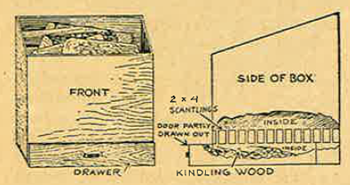
--ERNEST CAHILL, Freshwater, Que.
Churning in the Washing Machine
In most farm homes the best use of space, of time and energy as well as the best results for money expended are problems to be considered.We have found churning in the washing machine the best method we have tried for doing that very necessary piece of work. What we have found practical others may be interested in.
Our washer is an electric model machine. We had a cooper make a churn (sketch 1) 20 inches in diameter at the top and 18 inches in diameter at the bottom and 24 inches high. In the centre of bottom we bored a hole 2½ inches deep in diameter--bolted a floor coupling over this and screwed in a piece of 2½ inch pipe 19 inches long. (Ill. A and B, fig. 3). This fits down over the agitator post of the washer.
To make the dash we had a 9-inch piece of inch square steel welded to a sleeve (Ill. 3-C) that exactly fitted the head of the agitator post. A 3 inch x 3 inch piece of hard wood 18 inches long was fashioned as illustrated (D Ill. 3). To this was attached paddles of hardwood 1 inch thick cut as illustrated (E and F). In the centre a 2½ inch hole ¾ inch deep was bored and the steel extension firmly fixed in the centre. The extensions fits on to agitator post. The pipe comes up into the wood of the dash (Ill. at G, fig. 3) preventing the cream splashing down the pipe into the washer. Hand loops (A, fig. 1) were attached so as to be above the washer tub. A small hole (A, fig. 2) was bored in the lid to let the air escape.
We made a butter tub by cutting down a tongued and grooved barrel as illustrated, fig 4. The churn and tub were stained cherry red and are attractive as well as thoroughly satisfactory to use. The total cost was less than $10.
We place the churn on a folding tub bench which rolls about and makes it easy to move--while the cream is ripening--when ready to churn two of the men lift it into the washer. This is usually done at meal time so no one need leave their work. Water is poured over the dash and lid and they are put in place and the churn is started in the same way as one would start the washer for washing. The three-quarters turn of the agitator post turns the dash sufficiently to churn the cream. The cream is churned at a slightly lower temperature as the motor warms it a bit. The churn will hold 6 or 7 gallons of cream. The length of time it takes to churn depends upon the quantity and quality of the cream as it does in any method of churning. The amount of electricity used is of course about the same as used in washing. The amount is small.
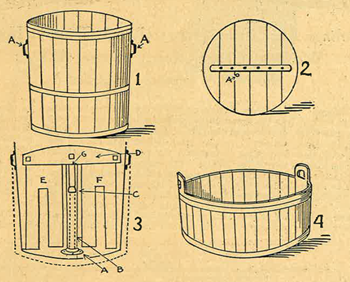
Just before the cream breaks, the motor should be turned off and the cream wiped down from lid and sides of churn. When done the butter is removed to the butter tub. The buttermilk is then dipped out. The churn can then be easily lifted from the washer. We have used our churn, which is, as far as we know, the only one like it in existence, for over two years.
--M. J. LUTES, Lutes Mountain, N.B.
Lets the Hens Open the Door
I am always interested in the handy devices in your magazine, and enclosed you will see a rough sketch of one I have used for the past two winters in my henhouse and it has never failed.
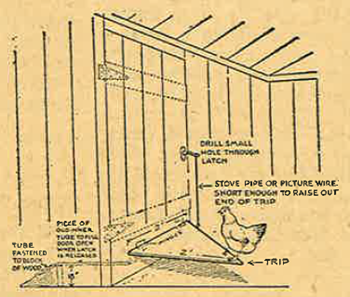
My henhouse comprises several pens, but the roosting pen is fitted up warmer than the others; at night after the hens have gone to roost I close the door with the trip on it, then in the morning when the first hen hops up on the trip, open flies the door, and they are feeding and scratching long before I am up on the cold winter mornings. The sketch shows the door open.
--O. L. CARSON, Domville, Ont.
Home-Made Brooder Stove
The accompanying plans and sketch I thought might prove useful for the “Handy Devices” page. It is for the construction of a stove suitable for brooder house or workshop. It burns wood or coal and may be made out of waste materials. We have used this stove and found it very convenient.
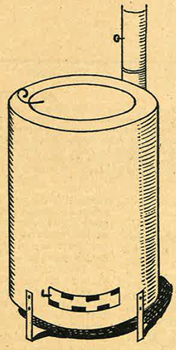
Procure a 12½ gallon grease drum (must be electrically welded). The first proceeding will be to cut the stove pipe hole. Make it 4 inches across and just at the top of the side, drill in a few places, then cut around with a chisel. Rivet a collar on the inside over the pipe elbow. The end of the elbow should be spread. A four-inch pipe is recommended.
Next the damper must be cut in the bottom, directly opposite the pipe. Cut out of piece 3 inches high by 7 inches long with a hack saw. Groove the cut an inch deeper in three sections, top and bottom. Bend each alternate flap in. A slide may be made five inches by nine inches to act as a damper. A round grate may be cut from the brander of an old stove. Bolt on four legs any length preferred and a piece of scrap iron on the lid for a lifter. For a brooder house have a small-sized wagon tire filled with gravel under the stove in case of overheating.
--BRUCEITE, Ont.
Emergency Water Bag
While traveling through a desolate part of the country last summer, I found my motor hot, the water line leaking and water half gone. I stopped the leak, but could not travel further. Without anything to hold water while bringing it from a creek, I hit on the idea of making a water bag from an old blown-out inner tube that I had.
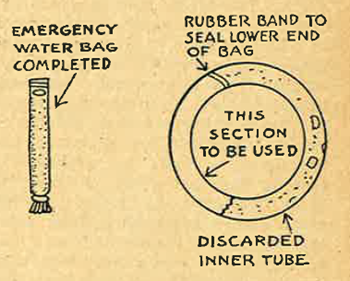
This was cut as shown, the bottom end tied tightly with a strip of the rubber and handles cut out at the top. It served the purpose then, and is kept for similar emergencies.
--WM. H. KETTLES, R.R. No. 1, Richmond, Ont.
Handy Tool or Clothes Hook
This is a link from a horse harness trace with part of one side cut out to hang on a wire fence in a field and used to hold a pail of drinking water, a coat or sweater, or tools, which a farmer may have while working in a field and in case the day becomes very warm he can hang his outside clothes on this double hook, on the fence.
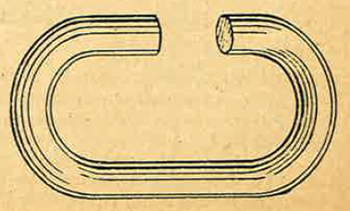
This hook can also be made from a piece of scrap iron. It can save time because a man would only need to look at the fence for his coat or sweater or drinking water when he needed them, instead of leaving them hidden in tall grass where he might have to search some time for them. Also this double hook can be taken from one field to another.
--ERNEST CAHILL, Freshwater, Quebec.